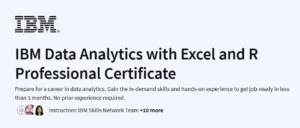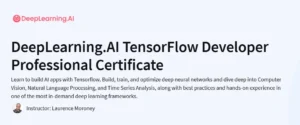What will you learn in Introduction to Data Science with Python Course
Utilize Python’s data ecosystem: NumPy for arrays, pandas for DataFrames, and Matplotlib/Seaborn for visualization
Perform data ingestion, cleaning, and transformation on real-world datasets
Apply exploratory data analysis (EDA) techniques to uncover patterns and insights
Implement fundamental statistical methods: descriptive stats, hypothesis testing, and regression
Build and evaluate simple machine learning models (e.g., linear regression, decision trees) with scikit-learn
Program Overview
Module 1: Python for Data Science Setup
⏳ 1 week
Topics: Conda environments, Jupyter notebooks, Python basics refresher
Hands-on: Configure your environment and load CSV/JSON data into pandas
Module 2: Numerical Computing with NumPy
⏳ 1 week
Topics: ndarray operations, broadcasting, vectorized computations
Hands-on: Analyze large numeric arrays for summary statistics and transformations
Module 3: Data Wrangling with pandas
⏳ 1 week
Topics: DataFrame creation, indexing, grouping, merging, and pivot tables
Hands-on: Clean and reshape a messy dataset with missing values and inconsistent formats
Module 4: Data Visualization
⏳ 1 week
Topics: Matplotlib fundamentals, Seaborn plot types, customizing aesthetics
Hands-on: Create histograms, boxplots, heatmaps, and multi-facet visualizations to tell a story
Module 5: Exploratory Data Analysis (EDA)
⏳ 1 week
Topics: Outlier detection, correlation analysis, feature engineering basics
Hands-on: Perform end-to-end EDA on a public dataset to identify key drivers and relationships
Module 6: Statistics for Data Science
⏳ 1 week
Topics: Descriptive statistics, probability distributions, confidence intervals, t-tests
Hands-on: Test hypotheses (e.g., A/B test scenario) and interpret p-values
Module 7: Introduction to Machine Learning
⏳ 1 week
Topics: Supervised learning workflow, train/test split, regression vs. classification, overfitting
Hands-on: Build and evaluate a linear regression and a decision-tree classifier using scikit-learn
Module 8: Capstone Project
⏳ 1 week
Topics: Problem scoping, model selection, performance metrics, storytelling with insights
Hands-on: Complete a mini data science project: from data ingestion through model deployment mock-up
Get certificate
Job Outlook
Data science skills with Python are in high demand for roles like Data Analyst, Junior Data Scientist, and Business Intelligence Developer
Industries span finance, healthcare, e-commerce, and tech startups, with entry-level salaries typically $70,000–$90,000
Foundational knowledge opens pathways to advanced specializations in machine learning, deep learning, and big data engineering
Specification: Introduction to Data Science with Python
|
FAQs
- No prior experience is required; basic familiarity with Python is helpful.
- The course introduces data science concepts gradually, from basics to practical applications.
- Beginners can follow hands-on exercises to understand data manipulation and analysis.
- Basic knowledge of math or statistics is beneficial but not mandatory.
- By the end, learners can perform basic data analysis and visualization using Python.
- Yes, the course covers popular Python libraries like Pandas, NumPy, and Matplotlib.
- Learners practice loading, cleaning, and analyzing data efficiently.
- Techniques include handling missing values, filtering data, and aggregating statistics.
- Hands-on exercises help develop practical skills for real-world datasets.
- Advanced data manipulation may require additional study.
- Yes, the course teaches creating charts, graphs, and plots using Python visualization tools.
- Learners practice generating line plots, bar charts, histograms, and scatter plots.
- Techniques include customizing visuals for better interpretation and storytelling.
- Hands-on exercises help learners understand trends, patterns, and insights from data.
- Advanced visualization techniques may require additional libraries or learning.
- Yes, the course introduces fundamental statistics like mean, median, standard deviation, and correlation.
- Learners practice applying statistical concepts to analyze and interpret datasets.
- Concepts help in understanding trends, distributions, and relationships within data.
- Hands-on exercises integrate Python programming with statistical analysis.
- Advanced statistical modeling may require further study beyond this course.
- Yes, the course provides foundational skills for data analysis and visualization projects.
- Learners gain hands-on experience that can be applied in real-world scenarios.
- Concepts learned form a basis for advanced data science, machine learning, or analytics courses.
- Projects help showcase skills for portfolios, internships, or career advancement.
- Advanced projects or professional-level applications may require additional practice and study.





